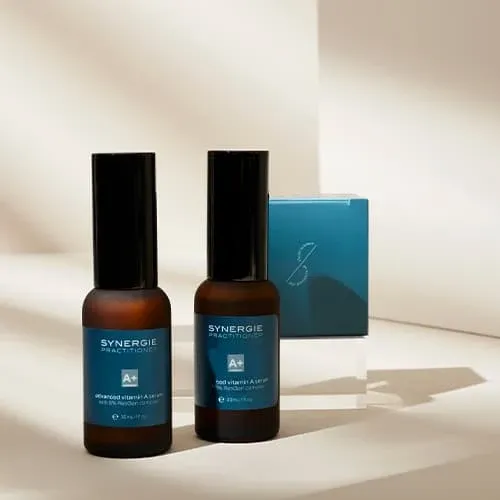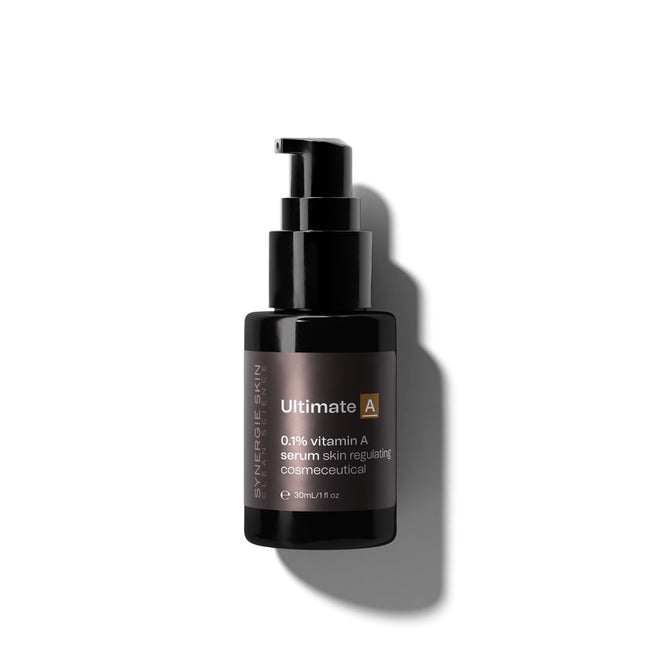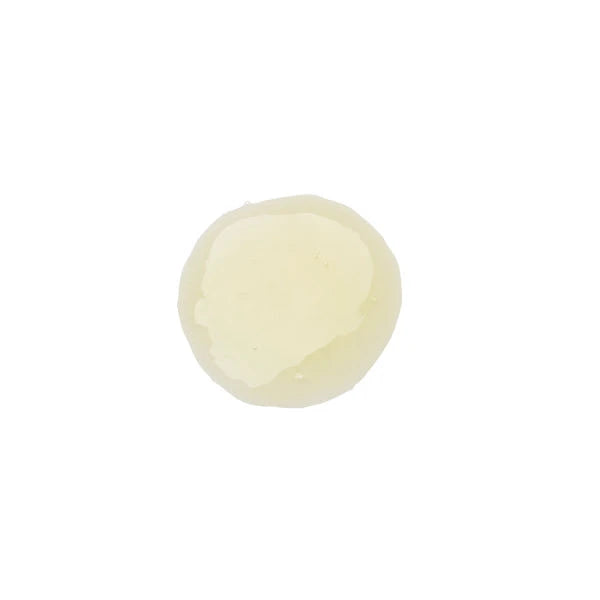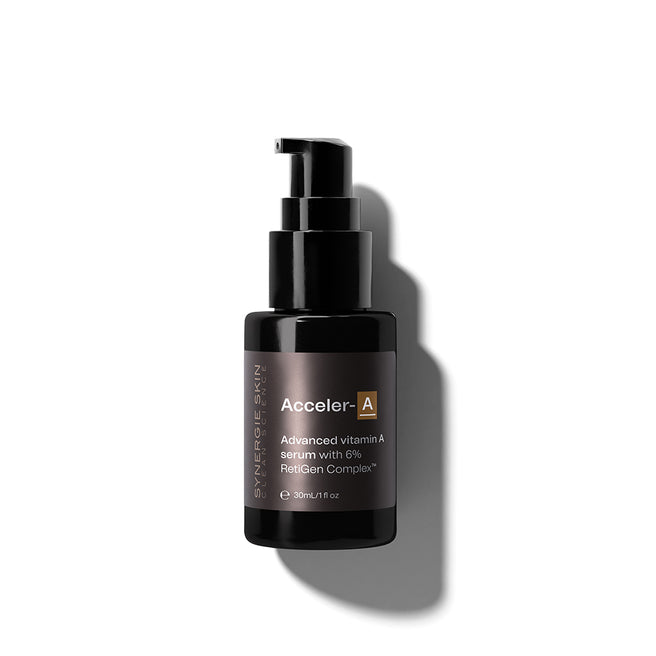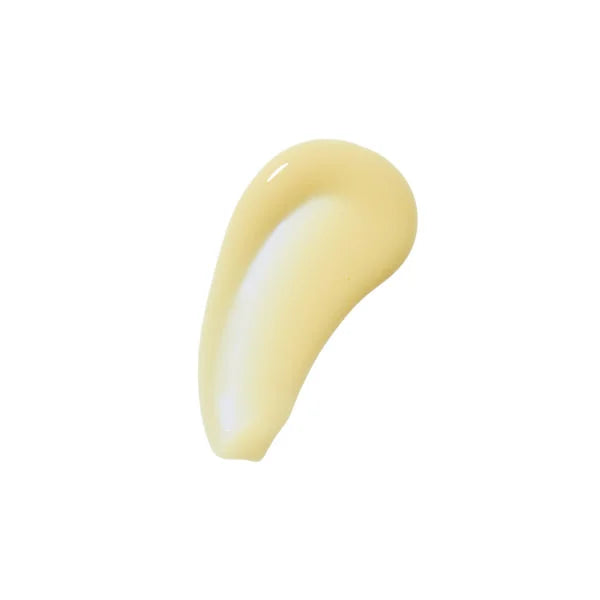
Vitamin A is considered to be the gold standard cosmeceutical for almost all skin types. Dr. Albert Kligman first harnessed the power of vitamin A as an essential skin ingredient in the form of retinoic acid; a highly effective remedy for acne sufferers that regulates the oil glands and cell turnover. Kligman went on to determine that this clever retinoic acid molecule was also able to reduce skin pigmentation and address fine lines in many of his patients.
Fast forward over fifty years and retinoids are still considered the royal family of cosmeceuticals. Vitamin A has been used to address the visible signs of ageing whilst addressing over 125 skin conditions including acne, psoriasis, pigmentation, wrinkle reduction, and sun damage. However, not all types of vitamin A are suitable for every skin type, and it can often be challenging to find clear answers when prescribing for your own skin concerns. So let’s take a deep dive into the facts of vitamin A.
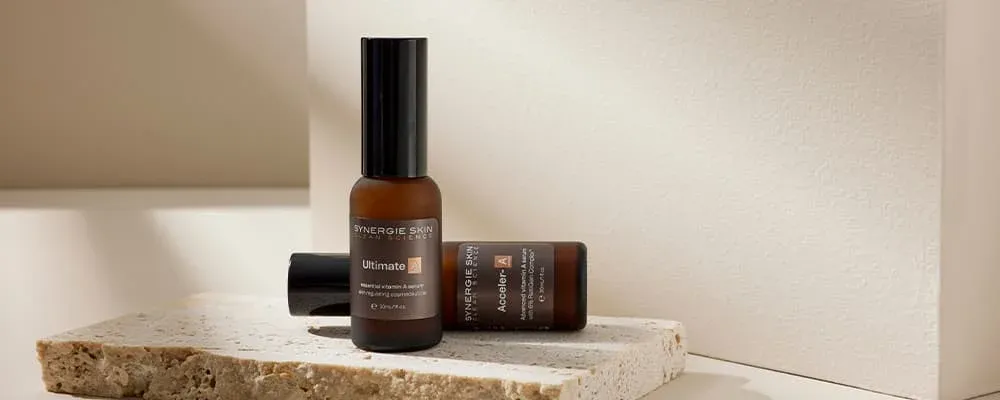
Benefits of Vitamin A
Vitamin A is often referred to as the great ‘cellular regulator’ due to its ability to control cell growth and differentiation. Retinoids (the various forms of vitamin A) are extremely powerful as they are able to program our genes (DNA) in the nucleus of our cells to perform many of our cell functions. How amazing is that!
The following are some specific functions of vitamin A on the skin:
Oil Regulation for Acne
One of the most effective topical treatments for overactive oil (sebaceous) glands is retinoids. Oil gland cells (sebocytes) are overly active in acne sufferers, and have receptors on their surface that bind to vitamin A. This initiates a cascade of events that normalises their growth pattern to reduce sebum (oil) production. Retinoids cause oil glands to decrease in size and reduce their growth rate, resulting in dramatically decreased oil production. A win for acne sufferers and those with excessively oily skin!
Pigmentation Reduction
Vitamin A reduces the activity of tyrosinase, an enzyme critical to producing melanin. Vitamin A also reduces the clumping of pigment in the base of the epidermis and makes the pigment particles (melanosomes) smaller and less visible. Furthermore, because the cells are turning over in an orderly manner, the excess pigment trapped in the upper layer of the skin is removed more efficiently.
Sun Damage Reversal
UV light increases the production of substances called MMPs, enzymes which break down our collagen. Vitamin A inhibits these MMP’s and, as a result, helps to preserve healthy collagen. It is also able to reverse damaging and sometimes lethal DNA mutations in our cells, which are caused by UVA and UVB light.
Collagen Stimulation
Vitamin A causes stimulation of fibroblasts; the cells that make collagen in the deeper skin layers (dermis), resulting in a reduction of fine lines.
Regulation of Cell Turnover
On the nucleus of our cells, there are special receptors (RARs and RXRs) that are specific to vitamin A. It’s important to understand that all the different types of vitamin A in skincare products MUST be converted to retinoic acid in the skin cells so that our skin can enjoy all the incredible benefits of vitamin A. When retinoic acid binds to these receptors (mainly in the epidermis of the skin) the DNA is programmed to normalise the turnover of our skin cells; allowing them to shed efficiently and causing the skin to glow with health. Vitamin A also reduces cell inflammation and over-production whilst thickening the epidermis to give a more youthful appearance to the skin.
Types of Vitamin A
Over the years, vitamin A has evolved to become increasingly stable, elegant, and specific in its action upon the cells. Vitamin A for the skin is referred to as the family of 'retinoids'. Within this family, there are a number of different compounds:
1. Retinol
This derivative is one of the most popular non-prescription forms of vitamin A, and is converted to potent retinoic acid in the keratinocytes. This retinoid is relatively unstable in air and light; it should be stabilised in a liposome to maintain its effectiveness.
Stabilised Retinol
This retinol features minimal irritation, is highly stabilised, has clinically proven efficacy and can reach deeper penetration. Its only drawback is that it needs to be broken down by our cells in to the form of vitamin A that our skin can recognise retinoic acid. It is very important that stabilised retinol has a great delivery system to the target skin cells.
2. Prescription Tretinoin (all trans retinoic acid)
This is the most potent form of vitamin A that requires a doctor’s prescription. This compound is an isomer found in isotretinoin, which was developed in the 1950s and originally branded as Accutane and Roaccutane. Although the medical retinoid Tretinoin (all trans retinoic acid) is highly effective at clearing severe, cystic acne, it is unstable, susceptible to oxidation, and comes at the risk of various side effects including skin irritation and dry skin. The oral form of Tretinoin has also been linked to birth defects.
3. Retinaldehyde
Intermediate form of vitamin A. This retinoid is more effective in vitro than retinol, but has poor shelf stability.
4. Retinyl palmitate
Ester form of vitamin A. Although this retinoid has reasonable stability and low irritation, it is considered less effective and has been superseded by more effective forms.
5. Hydroxy pinacolone retinoate (HPR)
This is the newest and - in my opinion as a cosmetic chemist - the best retinoid derivative on the block. Unlike other derivatives, this next generation vitamin A ingredient is recognised by the retinoid receptors. It requires no metabolic conversion to retinoic acid by the target cell to exert its numerous beneficial effects. HPR is an ester of all-trans retinoic acid capable of binding directly to retinoid receptors and enhancing gene expression. It is the fastest acting and most potent form of vitamin A, next only to prescription retinoic acid - without the dryness and flaking! Clinical studies demonstrate that HPR visibly reduces the appearance of lines and wrinkles in as little as 14 days.
Vitamin A Specifications
| Retinyl Palmitate | Raw Unstabilised Retinol | Retinaldehyde | Hydroxy Pinacolone Retinoate (HPR) | Tretinoin | Stabilised Retinol | |
| Size of Molecule for Penetration | High | Low | Low | Low | Low | Low |
| Stability | High | Low | Low | High | Low | Low |
| Effectiveness | Low | Medium | Medium | High | Low | High |
| Skin Irritation | Low | Medium, depending on formula | Low | Very Low | High | Low |
| Doctor's Prescription Needed | No | No | No | No | Yes | No |
Suitability of Vitamin A
It is important to understand that all retinoids eventually finish their journey as retinoic acid that binds to the DNA receptor sites of skin cells, however, the method of delivery for each retinoid produces a wide range of results, with some being more preferable than others.
Stabilised Retinol
Vitamin A has evolved into a more stable, elegant, and improved delivery system with minimal risk of irritation to the user. When retinol penetrates the cell, it is converted to retinoic acid in the cells. It then combines with receptors in the nucleus where it exerts its biological effects without irritation. Stabilised retinol comes out on top in this department as it offers enhanced penetration and stability versus traditional retinol.
Prescription Tretinoin
Prescription retinoids definitely work as this form of vitamin A needs no breakdown to act on the target cells. The issue with prescription Tretinoin (retinoic acid) is that the molecule binds to undesired receptors not involved in the expected effects of vitamin A. These undesirable side effects include:
- Flaking due to decreased ceramide production (lipid molecules in the skin that form a barrier to keep the skin moisturised)
- Irritation
- Redness
Consequently, patients tend to discontinue use or take time to build tolerance. Doctors recommend gradually increasing tolerance over 3 months and not to mix with acidic products, but many patients do not comply with this suggested regimen, which often causes unwanted reactions.
Retinyl palmitate
This form of vitamin A was very popular in the ‘90s but by today’s standards, it is a very large molecule which has difficulty penetrating the target cells to create any real benefit on the skin.
Retinaldehyde
While this ingredient is only one step away from its final active form of retinoic acid, it does not have the requisite the shelf life to make it a practical skincare option for most people. It showed great promise when it was first released as a cosmeceutical years ago, but it didn’t make the cut in my lab.
Retinol
This remains one of the most popular forms of vitamin A used by today’s cosmetic chemists. It’s best to look for products that use the stabilised forms and don’t mix them with low pH acidic products containing AHAs, BHAs, and ascorbic acid because they make retinol less active on the skin.
Hydroxy pinacolone retinoate (HPR):
The standout benefit of HPR is that, like retinoic acid, it directly interacts with receptors in the skin cells and doesn’t need to be converted to retinoic acid like the other retinoids. According to a 2018 study in The Journal of the American Academy of Dermatology, HPR was found to be an effective alternative to tretinoin and without detrimental side effects. More than any other retinoid, HPR ticks all the boxes when it comes to efficacy without causing irritation to the skin.
Shop Synergie Skin’s Vitamin A range
An essential vitamin A serum for skin regulation
An advanced vitamin A serum for a rejuvenated, firm and clear complexion


